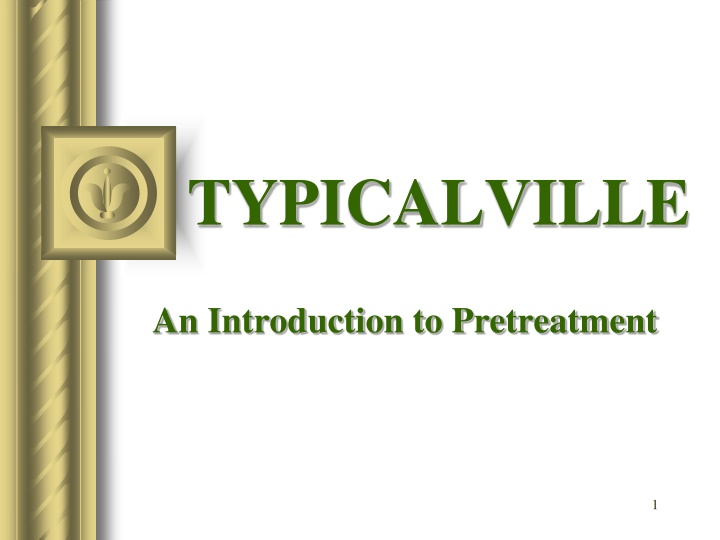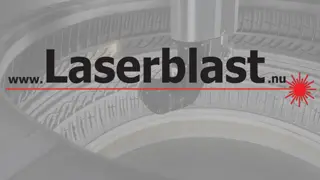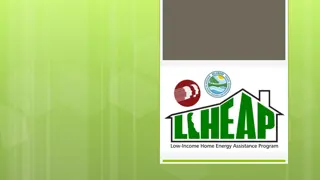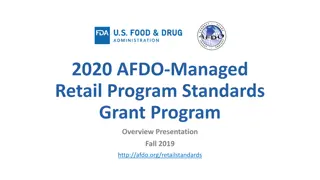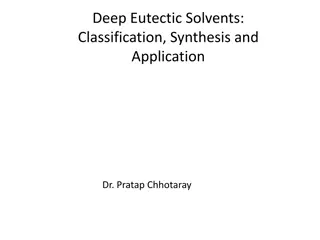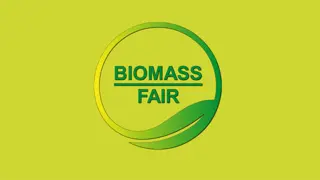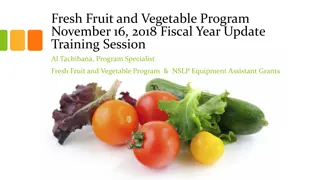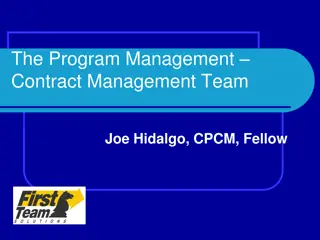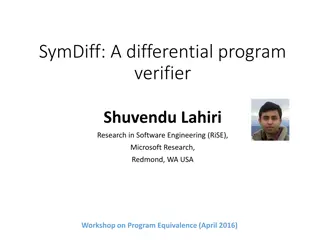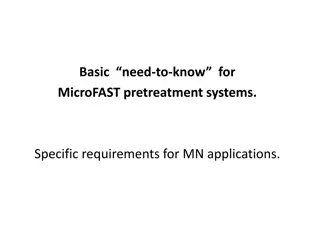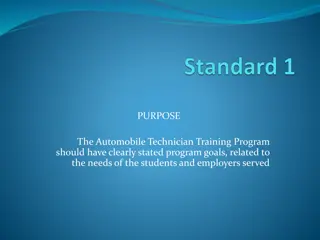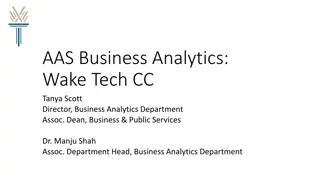Introduction to Pretreatment Program
Today's presentation covers the goals, history, and key elements of implementing a pretreatment program to protect the Publicly Owned Treatment Works (POTW) in Typicalville, North Carolina. Learn about the requirements for Significant Industrial Users (SIUs) and the evolution of pretreatment regulations over the years.
Download Presentation

Please find below an Image/Link to download the presentation.
The content on the website is provided AS IS for your information and personal use only. It may not be sold, licensed, or shared on other websites without obtaining consent from the author.If you encounter any issues during the download, it is possible that the publisher has removed the file from their server.
You are allowed to download the files provided on this website for personal or commercial use, subject to the condition that they are used lawfully. All files are the property of their respective owners.
The content on the website is provided AS IS for your information and personal use only. It may not be sold, licensed, or shared on other websites without obtaining consent from the author.
E N D
Presentation Transcript
TYPICALVILLE An Introduction to Pretreatment 1
Today's Presentation Goals of Pretreatment Program History of Pretreatment Pretreatment in North Carolina The Program Major program elements Files Inspections / Guidance / Training Summary and Contacts 2
Develop and Implement the Right Pretreatment Program Creating a Pretreatment Program that: Protects the POTW Is Environmentally sound Is Technically feasible Is Judicially defensible There is a delicate balance between these goals and protecting the POTW! If your Program doesn t do what you need it to do, change it! Too harsh or too weak, can cause extra work 3
TYPICALVILLE Commercial Industries WWTP Influent Aeration Basin Digester River Residential Farm Land 4
History of the Pretreatment Program 1972 Clean Water Act 1978- Federal Pretreatment regulations established 1982- EPA approval of the NC Program 1983/84 - majority of NC POTW Pretreatment Programs approved 1987-90 - major revision to NC and Federal pretreatment regulations 2005 Streamlining of the Pretreatment Program 2011 Revision to NC pretreatment regulations and model SUO 5
Got Pretreatment? Publicly Owned Treatment Works (POTWs) required to have a Pretreatment Program if process wastewater from Significant Industrial User (SIU) is accepted POTW = city, town, county, Sanitary District, Sewer Authority federally owned are exempt 6
Got Pretreatment? What is a SIU? To understand this, first learn - What is an IU? What is a Pretreatment Program supposed to do? 7
Whats an IU? User Person that discharges wastewater into the collection system Industrial User (IU). broadly intended to cover any User of the collection system (and WWTP) that is not a house maybe even some houses, too, for example someone doing large amounts of commercial cooking in their home 8
Whats the Purpose of the Pretreatment Program? Prevent Pass Through clean rivers, groundwater, and land compliance with NPDES+sludge limits Prevent Interference properly functioning + compliant WWTPs and collection systems Promote the beneficial use of biosolids good sludge for land application or composting Protect Worker Health and Safety 9
Three Limiting Criteria Biological Inhibition Aeration Basin Influent Pass Through NPDES and WQS Nitrification Aerobic/Anaerobic Digester Effluent Sludge Standards Ceiling and Cumulative 10
Pass Through cadmium load- based on NPDES Commercial NPDES Permit Limit= 2 g/l equal to NC Water SIU s NPDES Permit Limits Quality Std. bec stream flow zero at 10 year drought (7Q10) WWTP 5 MGD 50% RR Influent =4 ug/l MAHL =0.1668 #/day Water Quality Standards Residential Sludge Standards 11
Inhibition cadmium load Commercial SIU s NPDES Permit Limits WWTP Activated Sludge 1,000 g/l (41.7 lbs/ day) Influent to prevent inhibition Water Quality Standards Residential Sludge Standards 12
Sludge cadmiumload- based on 40 CFR 503 Commercial SIU s NPDES Permit Limits WWTP 50% RR 5 MGD 93 ug/l (3.9 lbs/day) Influent to prevent sludge problems Water Quality Standards Residential Sludge Standards- 34 lbs/acre 13
Evaluation of the most limiting criteria at the POTW 1) Pass Through Criteria - 4 ug/l 2) Biological Inhibition Criteria - 1,000 ug/l 3) Sludge Criteria - 93 ug/l Use the most limiting factor as the Maximum Allowable Headworks Load (MAHL) MAHL = 4 ug/l or 0.1668 lbs/day based on passthrough 14
Headworks Analysis (HWA) We have just performed a HWA, the technical basis of the Pretreatment Program! 15
What is a Significant Industrial User (SIU)? An IU with the potential to cause Pass Through (NPDES problems) Interference (collection system problems and inhibition) Bad biosolids Poor Worker Health and Safety 16
What is a Significant Industrial User (SIU)? large manufacturing facilities that discharge industrial process wastewater small industries such as a little metal finishing shop or a textile business companies that aren t typically considered industries such as hospitals or commercial laundries 17
What is a SIU? Significant Industrial User 15A NCAC 2H .0903(b)(33) >25,000 gal/day of process wastewater >5% MAHL for BOD, TSS, NH3 covered under Federal Categorical Pretreatment Regulations as a CIU any facility which the Control Authority or DWR believes has the potential to adversely impact the POTW 18
Whats a CIU? CIU=Categorical Industrial User A subset of SIUs (all CIUs are SIUs) a SIU that is covered by a specific Federal Categorical Regulation, for example: metal finisher pharmaceutical 19
Whats a non-SIU? IU that is not a SIU may or may not be issued a local IUP or other individual control mechanism 20
Pretreatment Program in North Carolina 615 Active SIUs (1200 in 1995, 900 in 2003, 784 in 2005) 35% metals 16% textile 12% food processors 5% laundries 5 % pharmaceuticals 4% OCPSF (Organic chemicals, plastics, and synthetic fibers) 23% other 21
Pretreatment Program in North Carolina 108 Active Pretreatment Programs Over 200 local POTW Pretreatment Coordinators and consultants DWR/DENR Pretreatment, Emergency Response, and Collection Systems Unit (PERCS) Regional Staff Other DWR and DENR staff interaction 22
DWR Responsibility DWR is Approval Authority Delegate DWR s responsibilities for Industrial Users under General Statutes to POTW. Approve POTW s Pretreatment Program, including review of each element and IUP. Compliance judgment and enforcement for failure to implement Pretreatment Program Training and Support! 23
POTW Responsibility POTW is Control Authority POTW is permittee of Approval Authority (DWR) Develop and Implement DWR approved Pretreatment Program Control Industrial Users through IUP and SUO Perform compliance judgment and take enforcement against IUs for failure to comply with IUP and SUO 24
SIU Responsibility SIU is Permittee of POTW Controlled by POTW Comply with SUO and IUP Keep POTW informed of SIU operations, including notification of changes before they make the change. 25
POTWs Role POTW s role toward SIUs same as DWR s role toward NPDES/Non- discharge permittees POTW+collection system like river basin LTMP/STMP+HWA vs. ambient monitoring network, basin plans, level Bs, TMDLs, RPAs SUO vs NCGS + .0100s + .0200s Permits, Compliance, Enforcement, Inspections and Audits PAR to DWR versus QNCR to EPA Goal is same - clean environment 26
Pretreatment Regulations Federal Clean Water Act Federal General Pretreatment Regulations - 40 CFR 403 NC General Statutes State Administrative Code - 15A NCAC 2H .0900 27
Full Program versus Modified Program Modified Program - 29 Programs POTW combined permitted flow of 2 MGD or less AND have 3 or less SIUs DWR determines who qualifies Short Term Monitoring Plan (once per 5 years) submit slightly smaller PAR Full Program - 79 Programs Long Term Monitoring Plan (on-going) Full PAR Required 28
Major Program Elements Sewer Use Ordinance (SUO) SIU Permits (IUP) Industrial Waste Survey (IWS) Monitoring Plan (MP) Long or Short Term (LTMP/STMP) Headworks Analysis (HWA) Allocation Table (AT) Sampling and Inspection Enforcement Response Plan (ERP) Pretreatment Annual Reports (PAR) 29
Sewer Use Ordinance (SUO) Adopted by the POTW s governing board Prohibited discharges Gives the POTW the authority to Control Users: Deny or Halt discharge Establish Local Limits Issue permits Enforce permits Issue penalties 30
What is a SIU Permit (IUP)? IUP= Industrial User Pretreatment Permit SIU= Significant Industrial User Like DWR permits, IUPs are issued under NCGS 143-215.1 DWR Director s authority under NCGS is delegated to POTW. Purpose is to protect POTW and environment. Same format as NPDES permits: Include limits, monitoring, reporting, general and specific conditions. 31
Pretreatment Permits versus Pretreatment Equipment SIU definition not tied to whether Industrial User (IU) has treatment units Not all SIUs have pretreatment equipment, but all SIUs have pretreatment permits (IUPs) Not all IUs (Industrial Users) are SIUs Not all IUs with pretreatment equipment are SIUs non-SIUs can be issued non-SIU (or local) IUPs 32
SUO and IUP POTW is Control Authority POTW controls what IU discharges and under what conditions SUO and IUP are Control Mechanisms SUO is general control of all IUs IUP is individual control mechanism for one specific SIU or non-SIU If SUO and IUP don t do what you need them to do, change them! Too harsh, too weak, can cause extra work 33
Industrial Waste Survey (IWS) Survey all industries connected to POTW Satellite communities who tells who? Determine who needs controlling or regulating (who is a SIU) Do you know when someone new is planning to move to town? Or only find out after already here?! Do you know when an IU or SIU makes a change to their process? Or only find out after already made it?! 34
Investigating your Collection System To the POTW 35
Long Term or Short Term Monitoring Plan POTW Site-Specific Sampling Plan collects data for use in Headworks Analysis (HWA) WWTP removal rates WWTP inhibition criteria WWTP influent + uncontrollable load Local Limits NPDES/Non-discharge permit Other applications Full Programs Long; Modified Short; Only difference is the frequency. 36
LTMP/STMP Pollutants of Concern (POCs)? NPDES Permit Limited Pollutants of Concern Sludge Regs (40 CFR 503)- As, Cd, Cu, Pb, Hg, Mo, Ni, Se, and Zn EPA Required- Cd, Cr, Cu, Pb, Ni, Zn SIU IUP Limits- Ag, CN, Chlorides, Fluoride, organics, etc. Not all POTWs have the same POCs A POTW s POCs can change over time 37
Typical LTMP/STMP Monitoring Locations at a WWTP 3 Bar Screen Clarifier Aeration Basin Aeration Basin 1 Grit Removal Filter Aerobic Digester 4 2 Sludge Chlorine Disinfect 38
Typical LTMP Monitoring Frequencies Full Programs have a LTMP Long Term Monitoring Plan Influent and Effluent - Quarterly Aeration Basin- Semi-annually Sludge to Disposal- per sludge permit Some POTWs do more Some POTWs allowed to do less in DWR approved LTMP 39
Typical STMP Monitoring Frequencies Modified Programs have a STMP- Short Term Monitoring Plan Influent and Effluent- One year of quarterly sampling once every 5 years Aeration Basin- once every 5 years Sludge to Disposal- per sludge permit Some POTWs do more 40
LTMP/STMP Detection Levels Detection levels must be approved by DWR in LTMP/STMP Comp Guide, Chapter 4, Appendices 4-A, 4-C, and 4-D, page 3 Some POTWs use lower Some POTWs allowed to use higher in DWR approved LTMP/STMP 41
LTMP/STMP Guidance Find yours. Understand and follow it. Comprehensive Guide, Chapter 4 Data Summaries - forms on website separate column for less than sign average, max, and min If LTMP/STMP doesn t do what you need it to do, change it! Too much, too little data, useless data Effluent LTMP/STMP data on DMRs All pollutants 42
Headworks Analysis (HWA) Technical Analysis of a WWTP Passthrough, inhibition, sludge Maximum Allowable Headworks Loading (MAHL) Maximum Allowable Industrial Loading (MAIL) HWA Workshops scheduled per POTW due dates/locations. PERCS specifically invites POTWs with upcoming HWAs due, but all are welcome! 43
Allocating the pollutant load Cadmium Allocation 15% SIU #1 SIU #2 Uncontrollable Reserve 65% 10% 10% 44
Allocating Cadmium 0.02502 lbs.day (15 ug/l @ 0.2 MGD) Commercial 0.1084 lbs.day (16.2 ug/l @ 0.8 MGD) 0.01668 lbs./day (1 ugl @ 1.89 MGD) combined Uncon. SIU #2 SIU #1 NPDES Permit Limits pounds/ day to meet NPDES Limit WWTP 5 MGD 0.0834 50% RR 0.1668 pounds/ day Influent Water Quality Standards Sludge Standards Residential 45
Allocation Table (AT) FLOW Permit Limits Cadmium Permit Limits Conc. mg/l 0.162 0.015 INDUSTRY NAMES Industry Permit/Pipe number 1 2 IUP Count 1 2 3 Load lbs/day 0.1084 0.02502 MGD gal/day 800,000 200,000 Gold Brick Metal Finishing Flying Monkey's Kitchen 0.8 0.2 0.13342 Column Totals => 1 400,000 Pass Thru 0.1668 0.01668 0.15012 0.13342 0.0167 11.12 % 10.01 % 0.0083 Basis for MAHL => NPDES MAHL from HWA (lbs/day) => Uncontrollable Loading from HWA (lbs/day) => Maximum Allowable Industrial Loading (lbs/day) => Total Permitted to Industry (lbs/day) => Total MAIL still available (lbs/day) => Total MAIL still available (%) => Total MAHL still available (%) => 5 % MAHL (lbs/day) => 5.0000 1.8690 3.1310 1.0000 2.1310 68.06 % 42.62 % 0.2500 46
Allocation Table SIU IUP limits Compute pounds/day Sum of SIU permitted load Compare against the MAHL and MAIL No over allocation! Find yours. Understand it. Comprehensive Guide, Chapter 6 47
HWA and MAHL How can I get a larger MAHL? Bigger river better removal rate site-specific inhibition criteria more land for sludge disposal 48
Pass Through cadmium load- based on NPDES Commercial NC WQS= 2 uq/l; 7Q10= SIU s NPDES Permit Limits 5 MGD (IWC= 50%); NPDES Permit Limit= 4 g/l WWTP 5 MGD 50% RR Influent =8 g/l MAHL = 0.3336 #/day to meet NPDES Limit Water Quality Standards Residential Sludge Standards 49
Compliance Judgment Is the SIU in compliance with the IUP or not? Compliance judgment responsibilities and required time frames in ERP. 50
